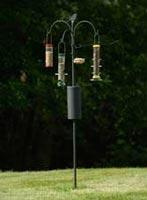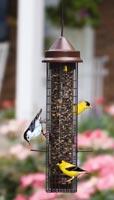Rodent Remedies
Done correctly, bird feeding will not attract rats. However, if there are rats or mice in your yard, then an unguarded source of birdseed can make them undesirably jubilant and visible. To prevent your birdfeeders from contributing to your rodents' larders, there are two things that need to be done:
Keep rodents off your feeder.
Keep food off the ground.
We are professional birdfeeders: these are the situations we set right every day of the week. Come in to the store and we'll walk you through your best options based on the feeders you have and the places you'd like to put them. We've helped thousands of people feed birds without problems and know what works. Fear and panic are not optimal solutions; the methods below are. Don't let the rodents win!
Non-Birdfeeding Preliminaries
In almost all cases, rodents seen feeding on birdfood are already present in the area: hanging up a feeder will not make rats suddenly materialize, but it can make the local residents more visible since we put birdfeeders out to watch, after all. We can make your birdfood inaccessible to rodents, but once you start peering out of your windows for scurrying creatures in the twilight, you may realize that there are indeed animals out there: mice, rats, and raccoons are ubiquitous inhabitants of almost all residential areas in our temperate climate. To seriously reduce your rodent population, you may need to:
- Remove as much rat shelter as possible: Potential problem sites around your home include openings in buildings, brush and debris piles, stacked wood, and thick patches of ivy and other groundcovers.
- Prevent access to food sources: We place bird feeders where we can watch them, so we often see rodents there quickly. But there are many other rodent food sources that we do not watch so closely. Make sure rodents cannot access garbage, compost piles, pet food, stored birdseed, dog waste (it's true!), BBQ grills, vegetable gardens, and fruit trees.
- On trapping: You can use snapping or electrical traps to kill individual rodents (put them out at night and place them in rodent-only boxes to prevent accidental harm to other animals). This can rapidly reduce local numbers, but unless you remove all or most food and shelter, the rodent population will soon rebound to pre-trapping levels. Do not use poison, as secondary poisoning can kill beneficial predators, resulting in higher rodent populations unless you keep putting out different poisons, in different locations, in perpetuity. Which you probably don't want to be doing, even irregardless of the harm to non-target wildlife.
1. Keep Rodents Off Feeders
Offer Foods that Rodents Don't Eat (Generally):
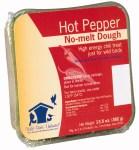 Hot Pepper suet or Hot Pepper-treated seed. Birds will not be affected by these foods, but they are highly distasteful to mammals. Hot Pepper suet cakes, cylinders, balls, and nuggets are easily substituted for other flavors, while you can also offer loose seed in a hot pepper form. See our selection of Hot Pepper foods in our online store.
Hot Pepper suet or Hot Pepper-treated seed. Birds will not be affected by these foods, but they are highly distasteful to mammals. Hot Pepper suet cakes, cylinders, balls, and nuggets are easily substituted for other flavors, while you can also offer loose seed in a hot pepper form. See our selection of Hot Pepper foods in our online store.- Nyjer for finches. Nyjer is a tiny seed which goldfinches will crack open to eat the edible interior; squirrels and rats are generally not interested in this seed. We have heard of occasional instances of exploratory animals damaging mesh finch socks; we recommend solid tube feeders with feeding ports specifically sized for Nyjer to prevent this. Note that Nyjer feeders only appeal to certain bird species and often have reduced activity during the summer months.
- Hummingbird nectar
For Seed and Nut Feeders, Block Rodent Access:
- A freestanding pole with a baffle (a metal disc or cylinder) will block climbing animals. A multi-armed pole as shown below allows to offer several foods of any kind, all protected by a single baffle.
- A hanging dome baffle will protect a feeder hanging in a tree, or perhaps hanging under a beam or pergola.
- Weight-sensitive feeders shut out rodents. See examples of these feeders, as well as the baffle techniques described here, on our Defeating Squirrels page.
- Most window feeders are safe from rodents, as long as placed a few feet away from any climbable walls, tree branches, etc.
|
Pole Baffle |
Dome Baffle |
Weight-sensitive Feeder |
Compared to athletic squirrels with 10 feet jumping ranges, rodents are relatively easy to block. Pole-mounted or dome baffles protect existing feeders, while difficult-to-baffle locations such as deck rail-mounted feeders can still be made inaccessible with weight-sensitive feeders such as the Squirrel Buster series.
2. Keep Food Off the Ground
If your feeders are not accessible to rodents, then all you have to do is keep the ground clean. In addition to using the "foods that rodents don't like" described above, there are ways to offer almost all foods without creating a mess on the ground.
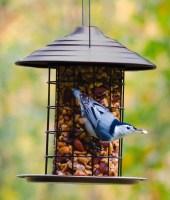 Use Inherently No Mess Foods:
Use Inherently No Mess Foods:
- Suet cakes, suet balls, suet nuggets, or spreadable Bark Butter. Shop our suet feeders here.
- Cylinders offer many of the same ingredients found in loose seed blends, but stuck together with gelatin to eliminate most messy "sorting" by the birds - each individual seed will need to be pecked off. Available in various no-mess options using ingredients such as suet, shelled sunflower, and nuts. Use a feeder with a tray like the one shown here for a totally no-mess option down to the last seed. Shop our cylinder feeders here.
- A tray feeder or cup-shaped treat feeder can be filled with loose, no-mess foods like suet nuggets, mealworms, oriole jelly, shelled peanuts, or shelled sunflower.
Clean Up Your Seed Feeding:
Traditional seed feeders attract a large volume and variety of birds and are the core of most feeding stations. Their popularity, however, has led to a lot of pet, hardware, and garden stores selling low quality foods and feeders that get people into trouble. Here's how to do seed right:
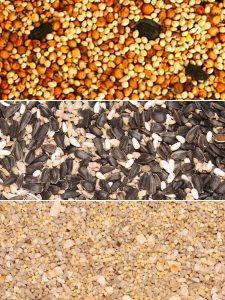 Level 1: Terrible Junk Seed
Level 1: Terrible Junk Seed
Poor quality mixes with filler seeds that birds won’t eat are the leading cause of rat-attracting messes. Many blends similar to the top one shown at right are available at grocery, hardware, or pet stores under the generic name of "wild bird seed." They use whatever is cheapest, regardless of whether the birds eat it: the large round reddish milo is one of the worst fillers, but also avoid significant use of cracked corn, wheat, canary seed, and mystery “grain products.” See our Seed Preference Guide for more information.
- Level 2: Decent Seed with No Fillers
A good seed mix should feature mainly sunflower (straight black oil sunflower is a good economical option too). Good secondary ingredients include nuts, safflower, or a limited amount of white millet (ground-feeding birds like it; most perching birds don't).
- Level 3: A 100% Edible No-Mess Blend
Even a decent mix with no filler ingredients may still have inedible shells, which leads to more "sorting" by birds, sometimes leaving behind edible material. Use 100% edible ingredients like shelled sunflower, hulled millet, or chopped nuts. As long as you have some ground-feeding birds like doves, towhees, sparrows, or quail, any small bits that fall beneath your feeder will quickly be consumed. Get our favorite No-Mess Blend here.
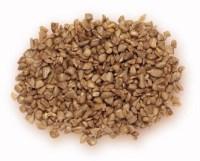 Level 4: Shelled Sunflower Only
Level 4: Shelled Sunflower Only
If you have few ground-feeding birds, you may want to eliminate the "picking and choosing and dropping" effect inherent to any mix of seeds by just offering a single ingredient. The favorite of all seed-eating birds is shelled sunflower, also called sunflower chips or sunflower hearts. You can get it online or in our Novato store. (A shelled peanut feeder attracts a slightly different group of birds, but is another excellent no-mess choice.)
- Level 5: Shelled Sunflower Only, with a Tray
I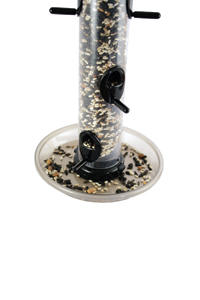 f you have very few ground-feeding birds, the way to completely eliminate residual food on the ground is to use a feeder with a tray. Some feeders have built-in trays, while you can add one to most good quality tube feeders. Then any dropped seeds will fall into the tray, from where they will still be eaten, and never reach the ground. A shelled sunflower feeder with a tray will drop nothing on the ground.
f you have very few ground-feeding birds, the way to completely eliminate residual food on the ground is to use a feeder with a tray. Some feeders have built-in trays, while you can add one to most good quality tube feeders. Then any dropped seeds will fall into the tray, from where they will still be eaten, and never reach the ground. A shelled sunflower feeder with a tray will drop nothing on the ground.


